In this blog post, we will provide a guide to geese in North Carolina. We will discuss their behavior, diet, and more!
What kind of geese are in North Carolina?
There are seven species of Geese in North Carolina:
- Canada goose
- Snow goose
- Ross’s Goose
- Cackling Goose
- Brant
- Barnacle Goose
- Greater White-Fronted Goose
There are also two species of swans in North Carolina – Tundra Swans and Trumpeter Swans.
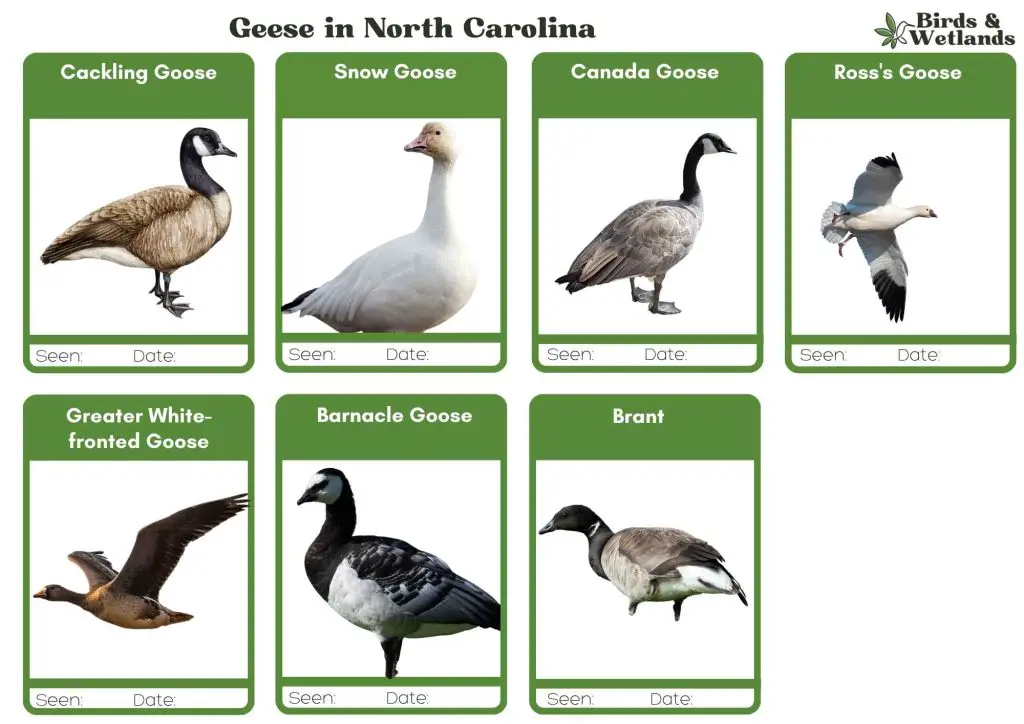
Canada Goose
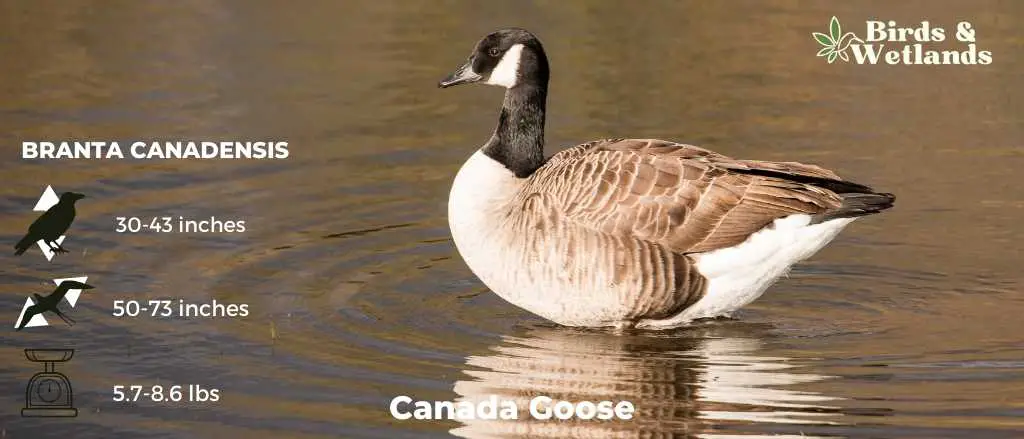
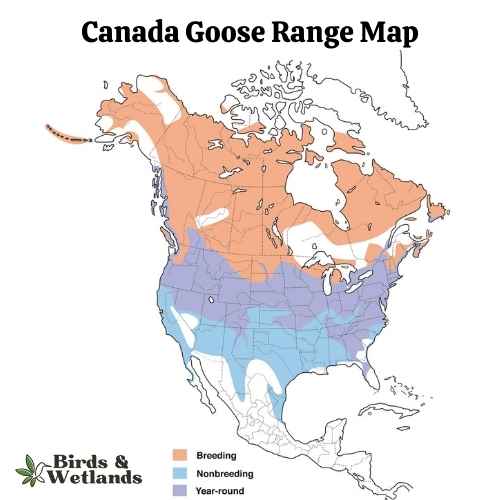
Canada Goose Sound
Scientific Name: Branta canadensis
Length: 30 to 43 in
Wingspan: 50–73 in
Weight: 5.7–14.3 lb
The Canada Goose is a large, well-known species of waterfowl noted for its distinctive appearance, familiar “honk,” and migratory behavior.
Appearance: Both male and female Canada Geese have a similar appearance, featuring a black head and neck with distinctive white patches on the cheeks and chin. The body is primarily brown with a lighter, often white, underbelly.
Diet: Canada Geese primarily feed on plant matter, including grasses, aquatic vegetation, and grains. They can often be seen grazing in parks, lawns, and fields, as well as dabbling in water bodies.
Reproduction: Canada Geese typically nest on the ground near water bodies, often on islands or other isolated areas to avoid predators. The female lays a clutch of about 4 to 6 eggs, which she incubates alone for around a month.
Snow Goose
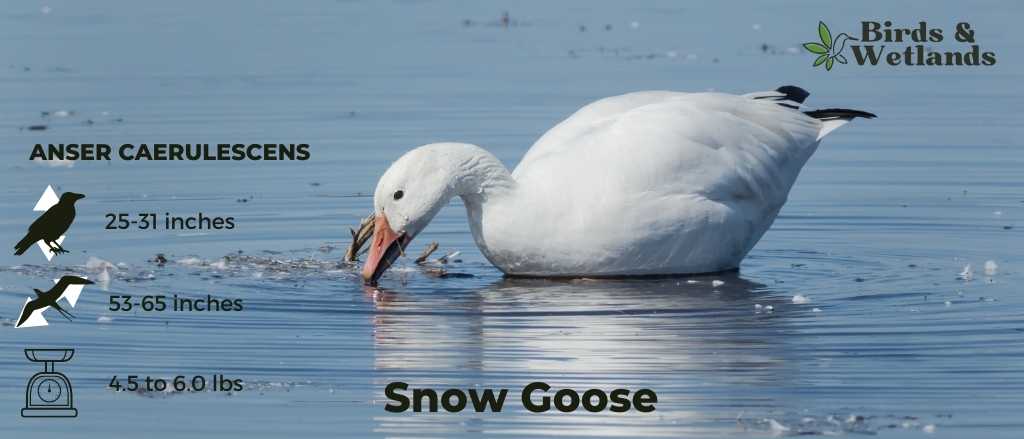
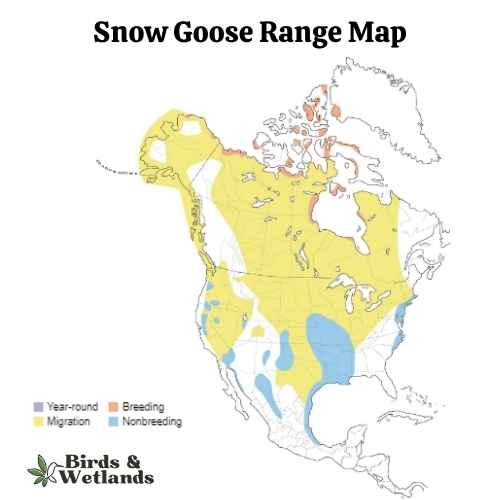
Snow Goose Sound
Scientific Name: Anser caerulescens
Length: 25 to 31 in
Wingspan: 53 to 65 in
Weight: 4.5 to 6.0
The Snow Goose is a large species of waterfowl known for its vibrant white plumage and significant migratory flights.
Appearance: True to their name, Snow Geese are predominantly white with black wingtips. They also have a pink bill, pink legs and feet. A color morph, known as the “Blue Goose,” displays a bluish-gray body with a white head, but is considered the same species.
Diet: Snow Geese primarily feed on plant matter, such as grasses, sedges, and small grains. They can often be seen in large flocks foraging in fields and marshes, and during migration and winter, they can cause considerable damage to agricultural fields due to their feeding habits.
Reproduction: Snow Geese typically nest on the tundra, near water bodies. The female builds the nest and lays a clutch of about 3 to 5 eggs, which she incubates alone for approximately three weeks. Once hatched, the goslings can feed themselves but stay with their parents for protection until they can fly.
Ross’s Goose
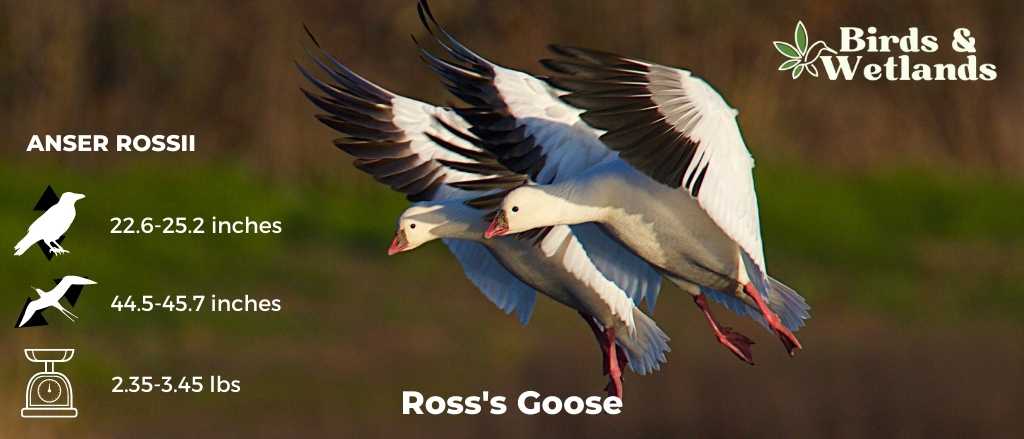
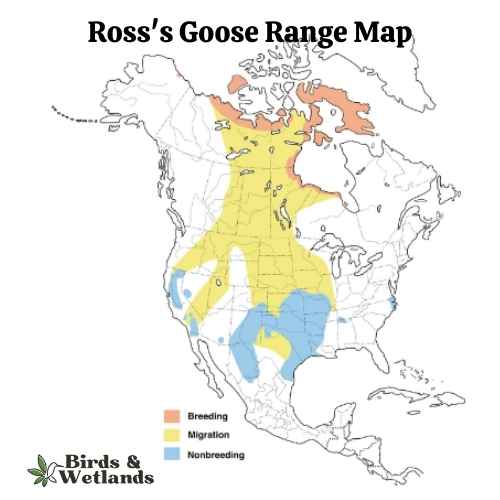
Listen
Scientific Name: Anser rossii
Length: 23.2-25.2
Wingspan: 44.5-45.7 in
Weight:42.3-55.3 oz
The Ross’s Goose is a small species of waterfowl often found in North America’s tundra and wetland habitats.
Appearance: Known for its compact size, the Ross’s Goose is mostly white with black wingtips. It features a short, stubby bill and a rounded head. One key identifying feature is the blueish gray base of its bill, which has a warty structure during the breeding season.
Diet: This goose feeds mainly on vegetation, including seeds, leaves, and roots of grasses and sedges. During winter and migration, they also consume grains and seeds from agricultural fields.
Reproduction: The Ross’s Goose nests on the ground, often in colonies. The female lays a clutch of 2 to 5 eggs which she incubates for around three weeks. The young geese, known as goslings, are precocial – they can walk, swim, and feed themselves shortly after hatching, although they stay with their parents until they learn to fly.
Cackling Goose
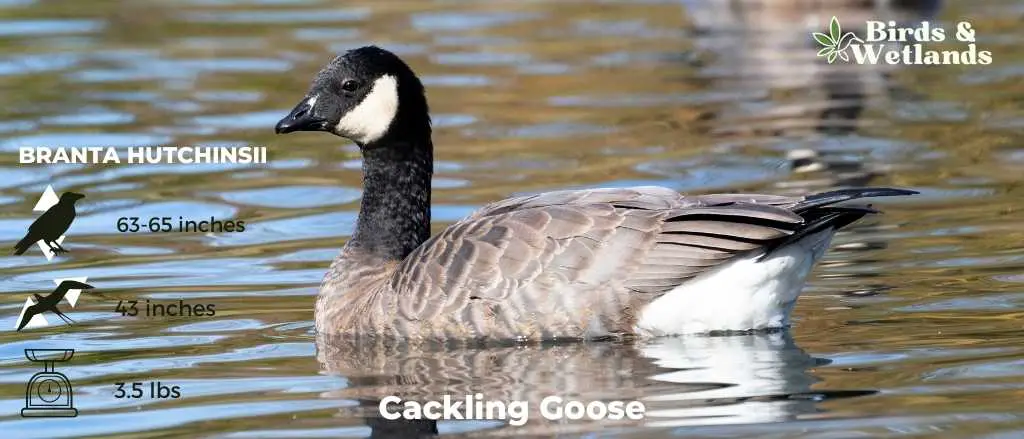
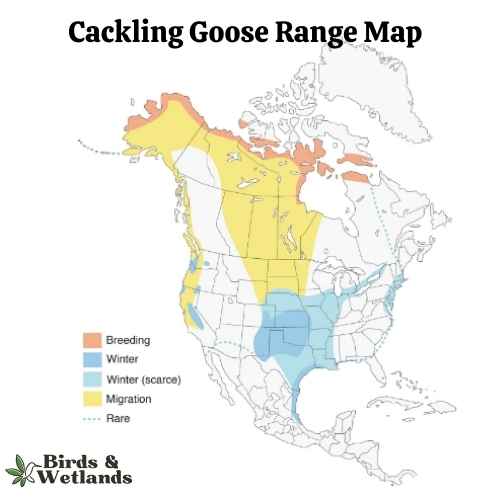
Listen
Scientific Name: Branta hutchinsii
Length: 24.8–25.6 in
Wingspan: 43-45.7 in
Weight:3.5 lbs
Cackling Geese are particularly known for their high-pitched, cackling calls, which is the source of their name. Despite their small size, these geese are renowned long-distance migrants, with some populations traveling thousands of miles between breeding and wintering grounds.
Appearance: With a similar color pattern to the larger Canada Goose, the Cackling Goose features a black head and neck, white chinstrap, light tan to cream chest, and brownish-grey body. One defining characteristic is its noticeably smaller size and stubbier neck compared to its larger counterparts.
Diet: Like many geese, the Cackling Goose’s diet mainly consists of plant matter. This includes grasses, seeds, and aquatic vegetation. They are often seen grazing on land or dabbling in shallow water.
Reproduction: Cackling Geese usually nest on the ground in elevated areas near water bodies, such as riverbanks or lakeshores. The female lays a clutch of 2 to 8 eggs and is responsible for incubation, while the male stands guard nearby. Incubation lasts for about a month.
Brant
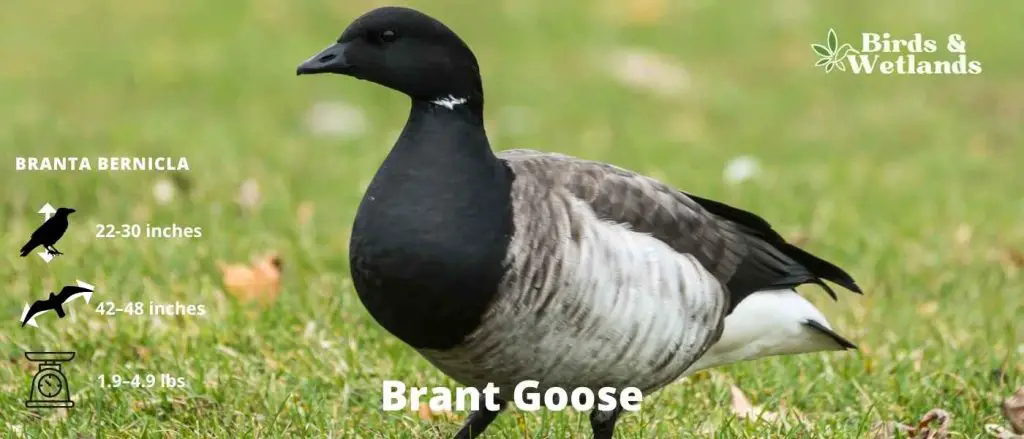
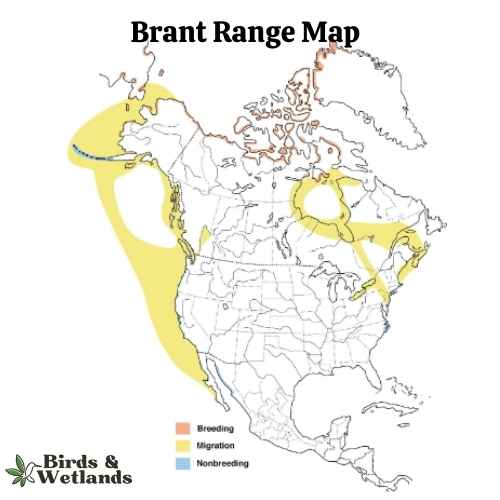
Listen
Scientific Name: Branta bernicla
Length: 22–26 in
Wingspan: 42–48 in
Weight: 1.9–4.9 lb
The Brant is a compact species of goose that is known for its striking appearance and interesting migratory patterns.
Appearance: The Brant is recognized for its dark, sooty color with a white crescent on the neck. The body is mostly black to dark gray, contrasting with the lighter underparts. Its small size, as compared to other geese, and short, stubby bill are other distinct features.
Diet: The Brant’s diet primarily consists of aquatic plants, especially eelgrass and sea lettuce. During the breeding season, they may also feed on grasses, sedges, and insects.
Reproduction: Brants typically breed in the high Arctic tundra. The female lays a clutch of 3 to 5 eggs in a ground nest, which she incubates for about a month.
Notably, Brants make an impressive long-distance migration every year. They spend their winters along both the east and west coasts of the United States and travel to the Arctic regions of Canada, Alaska, and even Russia to breed.
Barnacle Goose (Branta leucopsis)
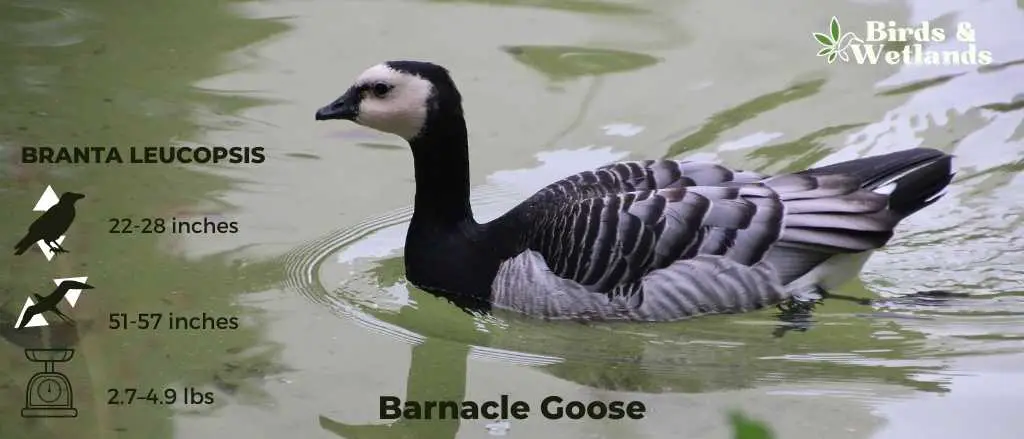
Rare in North America and when spotted its usually within a flock of Canada Geese.
- Scientific Name: Branta leucopsis
- Height: 55–70 cm (22–28 in)
- Wingspan: 130–145 cm (51–57 in)
- Weight: 1.21–2.23 kg (2.7–4.9 lb)
Barnacle Goose Description
The barnacle goose is a small goose with a white body and black wings, a black neck, with a white face and black bill. Its crown, eye line and legs are black.
Listen to Barnacle Goose
Barnacle Goose Habitat & Range
Barnacle geese are migratory geese that are native to the Arctic and northern Europe. They spend winters in southern Europe, Africa, India, and Australia. They breed in Iceland, Greenland, Northern Scandinavia, and Canada.
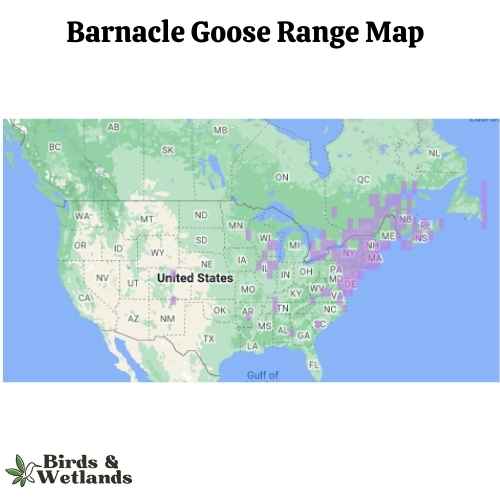
Barnacle Goose Diet
Barnacle Geese feed primarily on grasses, leaves, and other aquatic plants, grains, and algae during their breeding season but also consume insects during migration periods when food may be scarce.
Barnacle Goose Nesting
The Barnacle Goose lays 4-6 eggs in a nest lined with down but on the rock edge. The young Barnacle Goslings have to undergo significant challenges making their way from cliff edges to the water below a few hours after hatching.
Greater White-fronted Goose
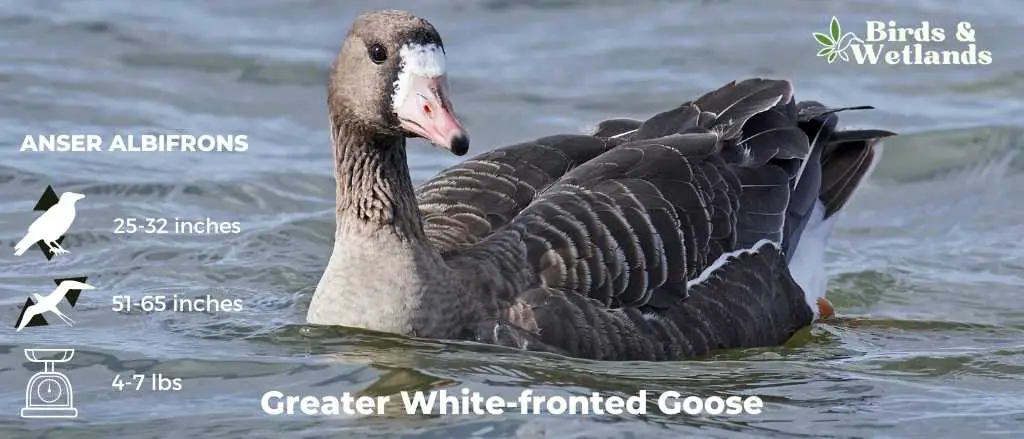
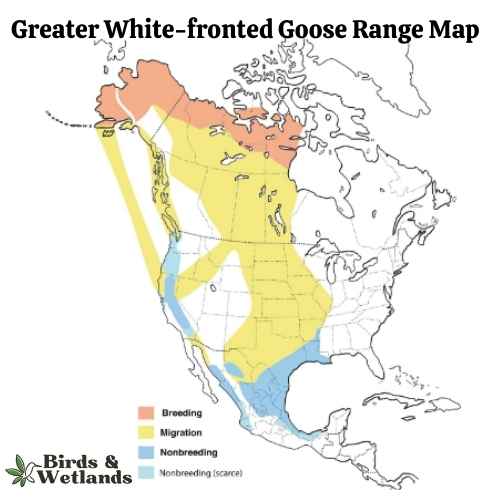
Listen
Scientific Name: Anser albifrons
Length: 25 to 31 in
Wingspan: 53 to 66 in
Weight: 3.3 to 6.6
The Greater White-fronted Goose is a medium to large waterfowl species, widely distributed across the Northern Hemisphere, particularly in North America.
Appearance: As the name suggests, these geese display a prominent white patch at the base of their bill. Their bodies are gray-brown, and their breasts are often marked with dark blotches. They possess a pinkish bill and orange legs and feet.
Diet: The Greater White-fronted Goose is a herbivore and feeds mainly on plant material. Its diet consists of grasses, sedges, grains, and berries. When wintering, these geese can often be found in agricultural fields, feasting on leftover grains and crops.
Reproduction: This species nests on the ground, often in areas with good visibility such as slopes or ridges. The female lays a clutch of 4 to 5 eggs, which she incubates for nearly a month. Once hatched, the young ones are taken care of by both parents until they are able to fly.
Are There Resident Geese Flocks in North Carolina?
Yes, whilst previously migratory Canada geese would only overwinter in NC, in recent years changes to migratory patterns mean many Canada geese are staying put all year round in the state.
There are huge flocks of snow geese in Northeast North Carolina, and in Central North Carolina you will find many goose species including Snow and Giant Canada Geese. The Canada goose in North Carolina typically averages over 11lbs in weight and is now resident year-round.
You can find them on golf courses, parks, farm fields and other agricultural fields and their diet includes aquatic vegetation, winter wheat and of course geese eat grass.
The main areas to find geese are Pocosin Lakes NWR, Lake Mattamuskeet and Pea Island.
Do Canadian Geese Migrate From NC?
Yes, Canadian geese typically migrate from North Carolina in the fall. They will typically head to southern states or even Mexico and Central America for the winter months.
In the spring, they will begin their journey back north to their breeding grounds. Some geese may stay in North Carolina year-round if the conditions are right.
Hunting Geese in North Carolina
September is the traditional time of year to hunt for resident Canada geese in North Carolina. The best way to find out when and where you can hunt them is to check the current regulations from the North Carolina Wildlife Resources Commission.
You’ll need to know the season dates, bag limits, and other requirements for your specific location.
Can You Shoot a Goose in North Carolina?
Yes, you can shoot geese in North Carolina. But several hunting methods are prohibited under federal regulations such as the use of rifles, pistols, swivel guns or shotguns larger than 10 gauge.
In addition, North Carolina has daily bag and possession limits on waterfowl hunting. For example, Brant has a daily bag limit of 1 and a possession limit of 3.
Where Can I Hunt Geese in North Carolina?
Geese congregate in Currituck Sound from late October through early February, making it an ideal spot for waterfowl hunting.
The best time to hunt is typically early in the morning or late in the afternoon when the birds are actively feeding.
There are several public hunting areas in Currituck County, including the Currituck Banks Reserve and the Currituck National Wildlife Refuge.
Is There a Goose Hunting Season in North Carolina?
The geese hunting season in North Carolina usually takes place from September to February.
Conclusion on Geese in North Carolina
If you’re looking to see some of North Carolina’s beautiful wildlife, keep your eyes peeled for flocks of geese. Whether they’re migrating through or have made North Carolina their permanent home, these birds are sure to add some beauty and interest to any landscape.


